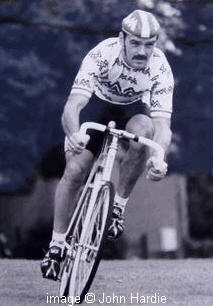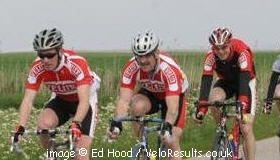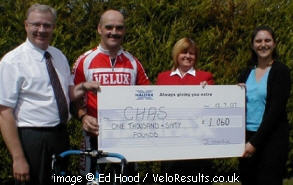Forget the super fast boards of Manchester. Imagine a track meeting whose roots go back to the year 1314; where the track is only 200 metres and one of the straights is bordered by a burn (that’s a stream in Queen’s English)… a track meeting which goes ahead even in a torrential rain – welcome to the world of the Highland Games, and one of Scotland’s greatest exponents of the form; John Hardie.
The Games at Ceres in Fife were originally held as a celebration by Bruce’s men returning victorious from Bannockburn. The original Games were basic tests of speed and strength, over the years the number of games grew and events became standardised.

A typical Games today will have, running; heavy events – shot putt, caber tossing, hammer, highland dance contests and cycling. There are some 30 plus meetings annually in Scotland as well as a number of similar style events in the Lakes.
The racing is now open but until relatively recently the riders were classified “unregistered professionals” and the events were not recognised by the Scottish Cyclists Union. The ruler of this era was John, a man from the Kingdom of Fife who, over 17 seasons from 1976 to 1992 won 65 championships, in 1982 he won all 8 titles on offer from 800 to 8000 metres.
Hardie’s uncle had been a grass-man after the war and seeing the promise in his young nephew, took him under his wing, giving him the benefit of his experience. At 16, in his debut season, Hardie won the one mile and three mile titles.
The training programmes his uncle framed were very much in the “Chariots of Fire” vein but based on sound ideas. Tyres were filled with water for road rides to increase resistance and build strength, likewise lead weights were sometimes placed in the seat tube. Intervals were done on grass, twice per week.
The regime paid dividends and Hardie built up a huge collection of titles. The titles were scratch events but all other events were run off in the Australian handicap style. Hardie won hundreds of these handicaps. On-course betting and beer tents are all part of the fun, Hardie would be trying to relax between events when worse-for-drink punters would appear and explain to him that a good result was required as the weeks wages were wagered on him!
Over the course of a season, riding 30 or more meetings, Hardie’s total audience would be in the region of 100,000 spectators! The track at Ceres is perhaps the most bizarre with its tight bends and yes, men have landed in the burn. Markinch track is on a hillside; Inverkeithing is cinders; the park at Inveraray hosts cows and sheep 364 days of the year and on a wet day is not the most hygienic of tracks. The quirky tracks played host to some real characters, the man Hardie usurped as Grass Track King was a miner from Fife named John Ward who as well as digging coal and riding the grass tracks ran an ice cream van. Ward would announce to the terrified youngster; “I’m the Master at this track Hardie!” I remember being out training as a young “tester”, I would sometimes see the legendary “Wardy” out doing his road work – on his grass track bike with no brakes!
Crash hats were reserved for the five mile championship on the regulation tarmac bowl at Caird Park used for Dundee Games but dismissed as “soft” for all other meets. In a similar vein, legs were never shaved. The bicycles used on the grass are unique, current UCI regulations tell us that the tip of the saddle must be 50mm behind the bracket centre line. On Hardie’s ancient Lindsay (inherited from his uncle), and all his subsequent machines, he sat some 35mm in front of the bracket centre line to keep weight over the front wheel and aid control. A home made support linked to the top tube prevented the saddle nose dropping.
The Lindsay was eventually retired and an old Hobbs of Barbican grass-specific frame obtained. Normal, tight clearance track frames are just too rigid and difficult to control on sun baked, rutted grass. The wheelbase was 42”cm (check your own road bike… my Giant is just under 40cm) and the clearances wide to allow mud and grass clear passage on wet days. Bottom bracket height was 11”cm. When the Hobbs eventually succumbed to one of the many crashes, Hardie took the frame to Dave Yates and asked for a diagnosis, Yates just laughed at the mangled remains and offered to build him a new, identical frame, Hardie accepted Yates’ proposal and this was the machine he used until the end of his career.
Initially hubs were Harden and Airlite but eventually John succumbed to the beauty of Campagnolo Pista, large flange. A pair of bamboo rims were at one time laced to the Airlites but proved too unresponsive and bouncy, Fiamme eventually became the perennial choice. Tyres were either Wolber Sports with the centre studs cut off, giving low drag on the straights but good grip when cranked over for the turns, or Barum G11s obtained on pilgrimages to Plum’s shop in Ghent. Dunlop rim cement backed up with cloth insulating tape wrapped round the tyre and rim stopped tyres rolling under the huge cornering forces. Gearing ranged from 72″ on a wet Ceres to 92″” on the tarmac of Dundee’s Caird Park with just about very ratio in between employed at some stage.

An ever increasing collection of broken bones caused Hardie to call it a day in the early 90’s. The Games are now “open” and legal, but John has hung up his grass track bamboo wheels for good.
He did, however, make a return from retirement recently to help raise money for the children’s hospice Rachel House, in Kinross. With support from Graham Johnston (of Fife Joinery Manufacturing LTD in Glenrothes), Jock travelled to Skjern in Denmark to take part in a cycle race organised by the Danish Cycling Federation.
Around 800 cyclists took part in the race – 88 of them were Danish Velux employees, and Jock completed the 105 kilometres (65miles) in 2hrs 31 mins, managing to come over the line first in his group.

Jock trained hard for two months before the event to get some of the old fitness back – he knew all too well that the pace and distance wouldn’t be easy.
John isn’t exactly considering a return to the grass tracks next season, but he is delighted that all his hard work paid off and he was able to hand over a cheque for :£1060 for his efforts.
John would like to thank everyone at Fife Joinery Manufacturing Ltd., as well as his family, friends & neighbours, for all their generous support, and VeloVeritas would like to thank John for his time.



